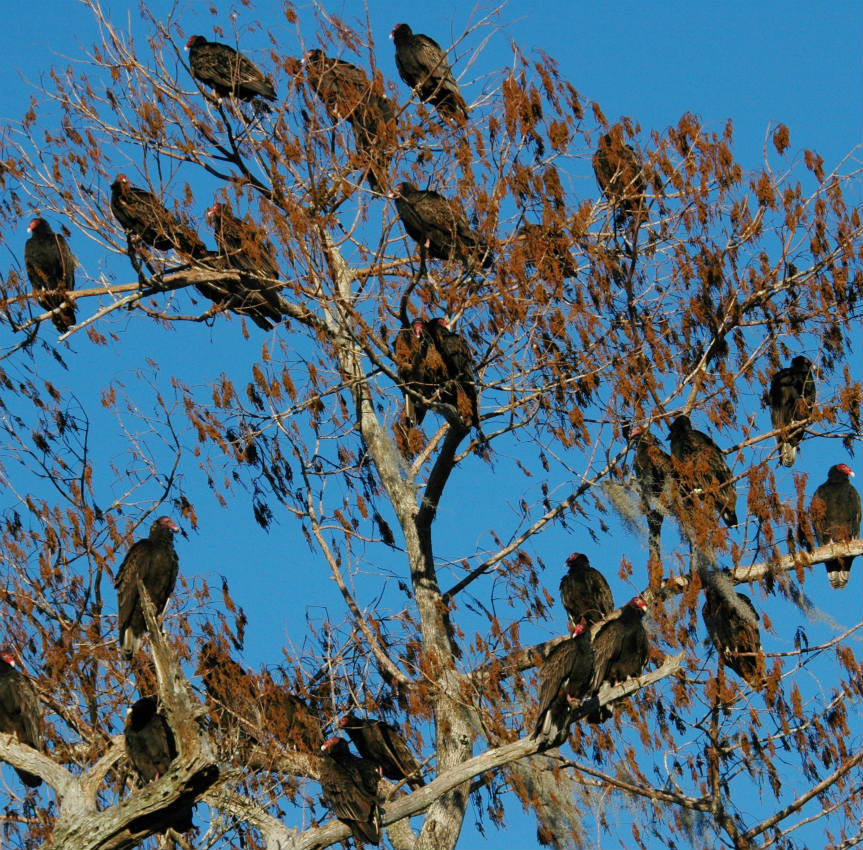A few scatological details notwithstanding, life must be reasonably good when a majority of the day is spent riding the thermal uplifts and doing lazy eights above the tree tops. Alone or with a few friends or family members, the cares of the world are hundreds of feet below.
It is true the public’s perception of turkey buzzards is somewhere between loathsome and disgusting. It is likely no one has ever deemed it complement to be called an old buzzard, or a young one for that matter.
Turkey buzzards are classified as New World Vultures residing in and above Wakulla County. There genetic cousins are other North and South American vultures, and California and Andean Condors.
Fossils from the Pleistocene epoch in Florida indicate the turkey buzzard had ancestors in residence during that active period of glacial encroachment. No doubt they were cleaning up sabre-tooth tiger leftovers.
Curiously there is not a close genetic relationship with vultures occupying Europe and Asia. These Old World Vultures are thought to have developed separately, but with similar traits which are employed for the same purposes and results.
Turkey buzzards are scavengers, but on rare occasions will attack small or helpless animals when their dining opportunities are limited. Most close encounters with these birds is roadside when they are enjoying the misfortune of some unlucky deer, armadillo or other road-kill.

Photo provided by UF/IFAS
Unlike many inhabitants of the avian world, buzzards do not have the vocal organ to chirp, crow, or trill. They can emit only a primeval grunt or raucous hisses which compound their image problem as crude savages.
Adding to their brutish image are their nesting skills. Turkey buzzard eggs are laid in protected areas with little to no nest construction.
In contrast to their harsh appearance and practices and as egalitarians, both the turkey buzzard male and female incubate the eggs. The young hatch in 30 to 40 days, and their flight training begins at ten weeks of age.
Turkey buzzards use there excellent site and efficient sense of smell to locate meals. This redundant system for finding fine dining is the envy of Old World Vultures which have to depend strictly on sharp eyesight.
The turkey buzzard’s superior sense of smell has been employed by natural gas companies for years. Natural Gas is odorless and undetectable when pumped to the surface.
A blend of chemical are added to natural gas as part of an odorant blend/safety effort. Gas pipeline leak detection is easier in remote areas because buzzards will confuse the added odor for carrion and circle above the source.
As leisurely graceful as turkey buzzards are in the air, their terra firma appearance is cartoonish. A featherless head, a tufted collar and a hopping gate make it an ideal candidate for mockery and distain.
Personal foibles and shortcomings aside, the turkey buzzard population tirelessly serves the citizens of Wakulla County as a seven-day-a-week clean-up crew. While no empirical been conducted, their no-cost removal of roadside dead animal likely saves taxpayers thousands of dollars in disposal cost.
Additionally, there is evidence their tidying labors minimizes the spread of some diseases which would occur in decaying flesh.
To learn more about turkey buzzards and their value to Wakulla County contact the UF/IFAS Wakulla County Extension Office at 850-926-3931 or https://blogs.ifas.ufl.edu/wakullaco/.
 0
0
